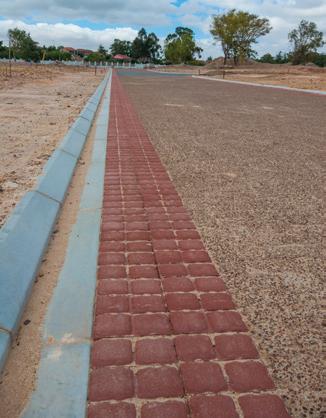
2 minute read
Mix-and-match pavers set the tone for Cape housing estate
Over 6 000m² of concrete pavers manufactured by CMA member Inca Concrete Products have been used to pave the roads of Bonsai Estate, a new housing project being brought to the market in Langerberg Ridge, Cape Town, by MSP Developments.
The central and by far the largest section of the roads was surfaced with Inca’s Table Mountain (Tan) Exposed Aggregate interlocking pavers, while the road edging and the colour breaks were laid with Inca’s Double Cobble pavers in two colours – red and charcoal. Produced to SANS 1058:2015 Class 2.0 specifications, the pavers are 70mm thick.
In addition, over 1 000m of kerbing was installed in four derivatives: CK5, MK10, BK2 and C1. It was supplied by Lascokerbs, a specialist kerb manufacturer which produces kerbs in a state-of-the art plant in Philippi, Cape Town.
The paving layout design was supplied by JVE Consulting Engineers and the paving was done by paving contractor GLC.
“We’re extremely proud of this project because it’s unleashed a very attractive layout which is unique to Inca. This is the first time that this paving combination has been used and it’s refreshing to note how one can achieve almost limitless diversity in design and appearance through the creative application of texture and colouring,” says Schalk van Wyk, Inca director of operations.
The layer works of the paved area comprise 150mm G5 sub-base aggregate and the pavers were bedded in 20mm of sand.
“One of the advantages of using our exposed aggregate pavers is that they’re less prone to showing tyre marks. More-over, the aggregate is imbedded throughout the whole paving block, so should any wear occur, the pavers will retain the same appearance,” says Van Wyk.
“Our pavers are tested on a regular basis for tensile splitting, abrasionresistance and water absorption at our in-house laboratory and our Tan Exposed Aggregate material through-mix is specifically designed to achieve a uniform, natural look that mimics and blends in with the natural environment.
“Another advantage of our interlocking paver is that once laid, it doesn’t move and forms an integrated whole. It’s also extremely strong, which is why the interlocker is so popular across the world. Furthermore, sections of paving can be removed for remedial work or new belowground installations and then replaced without patches or visible evidence,” explains Van Wyk.
Bonsai Estate is being developed in three phases. Phase 1, which comprises the construction of three-bedroomed homes, was begun in February. The construction of two-bedroomed apartments will follow.


(Above and left): Inca Concrete Products’ Tan Exposed Aggregate interlocking pavers and its TwinBlock Cobble are used creatively on Bonsai Estate’s roads.










